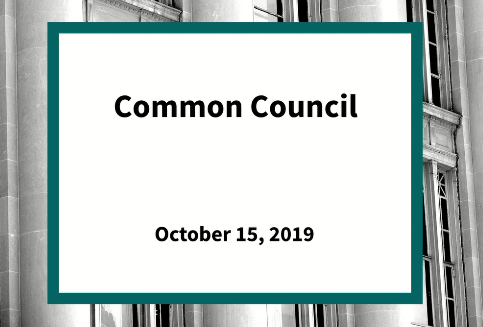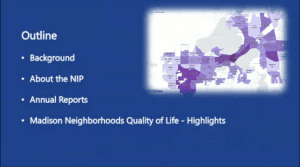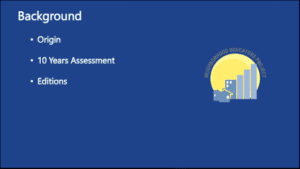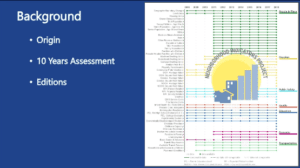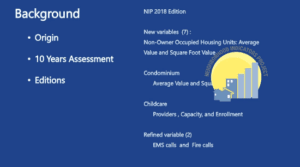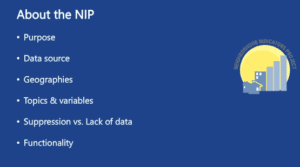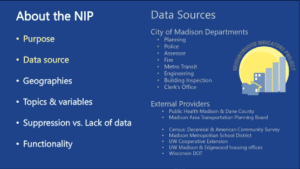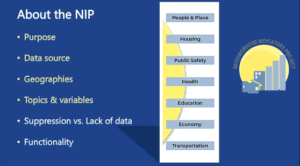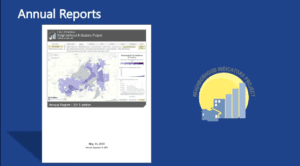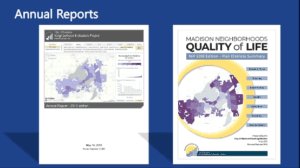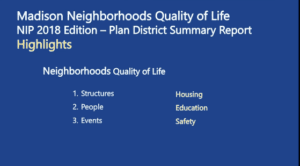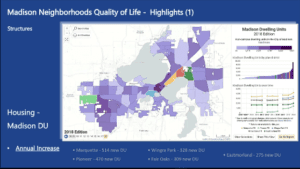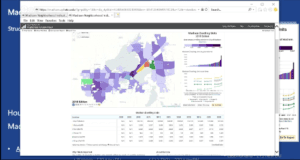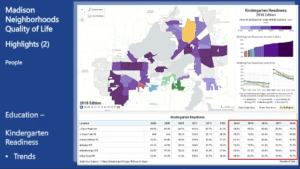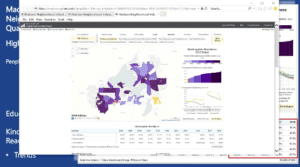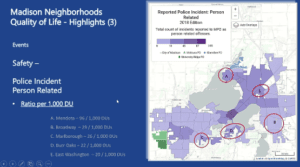The meeting was about an hour, not much on the agenda. I would have skipped it, but the honoring resolutions and neightborhood indicators presentation seemed important. Here’s the details (a day late!), CCEC covered more topics this time!
In case you want to watch for yourself
Mayor calls the meeting to order, all alders and mayor present except Arvina Martin (excused) and of course the vacant District 8 seat. They suspend the rules to take items out of order and introduce items at the end of the meeting.
Recognizing and Honoring 400 years of African American’s Heritage and Contributions in the United States of America.
Alder McKinney reads it but first says its an honor to be able to read this and thanks the former Poet Laureate Fabu Carter for the research. She shared the reading with Fabu Carter, Alders Samba Baldeh, Donna Moreland and Sheri Carter. Alder Sheri Carter asks Fabu, Alex Gee and Anothony Rubin and either Greg Jones or Theola Carter to represent NAACP to come up. She gives them plaques.
Anthony Rubin thanks them for recognizing the collective work of African Americans, often they are invisible in history and on a day-to-day business. He thinks its a honor for them to make the proclamation, this is an excellent start for a new mayor that inspires us all. It’s a new start for new leadership of this legislature that encourages us all. We are getting off to a great start. As he is happy we are recognizing these collective accomplishments. Today is a good day, but tomorrow we have to go out and continue to do the work. It’s not just about a proclamation or words because everyone has found ways to sell diversity and inclusion. It’s about changing the structures and changing the institutions and the ways of life so African Americans not only can be recognized for their work but they can feel like they are part of this city and part of this nation. Today is a good start but there is much work to do. He says the leaders standing up there will work with you, but we have to make a difference, we have to change the narrative and make a difference.
Alex Gee thanks them, he says his family was fortunate enough to spend a little time in Ghana West Africa this summer, before flying there he was with DC based NAACP members and they went to Jamestown Virginia to see where the Africans landed and flew out the next day and spent time in Jamestown. His heart was touched and encouraged as community leaders shook hands and welcomed they welcomed them home. In the Cape Coast Slave Dungeon – it’s called Slave Castles, but when you stand there you realize its a slave dungeon. Where 18 inches of human feces and waste once accumulated. They talked to them about the men and women who were chained in those places after being beaten and branded and separated from their families. While they were doing the tour one of the leaders pulled them aside and said you African Americans are the dependents of the strongest of the strong in Africa. They treated us like we were royalty because I survival which was given to us by them and our faith allowed us to come back and let them know that we had not forgotten who we were and had not forgotten Mother Africa. So this proclamation not only acknowledges the 400 years of treachery, but also 400 years of resilience. He came back from African thinking that is what he wants to build everything he is doing upon. The resilience that he recognized, that they were told about and that they need in the community. Inside each and every one as African American residents of Madison we have that within our DNA, or black Madisonians. We have that in our DNA, and given the chance and the support and removing unnecessary barriers we can prove to this community and the world that we are worthy dependents of these great folks and that we still bear the intelligence, brilliance and resilience to bring healing and difference to our community. Given that chance we will continue to make our community proud. So he appreciates this recognition and to connect with what Dr. Anthony said, this is just the beginning. We are looking back 400 years, but we want to look forward to the next 100 years to show you what can come with this proclamation and this great story of our people. Thank you for recognizing my family and the intrinsic value of African American people.
Theola Carter thanks them on behalf of NAACP and Greg Jones. She won’t repeat but echos what Dr. Gee and Dr. Rubin said. This year their Freedom Fund banquet theme was “When we fight, we win” and that “We” is all of us that are in here, our children, our grandparents and those who are here to come. Keep up the good fight.
Fabu Carter says it is an honor to use words to speak for those who could not speak for themselves.
Standing Ovation.
Passed unanimously on a voice vote.
Commending and thanking Alderperson Avra Reddy for her dedicated service to her constituents in District 8 and the City of Madison.
Shiva Bidar reads the resolution. Avra Reddy accepts the plaque and thanks people for being supportive over the past few weeks, she knows that the decision might have felt abrupt, but she took 3 months to make it. She didn’t have the emotional energy to tell everyone at once, but as soon as the resignation went out the amount of support she received was overwhelming, so thank you for that.
She shares a story, a few months ago in early June she was in a meeting with Syed (Abbas) and they were talking about single use plastic. She had her laptop out and she was looking at ideas on her laptop. The meeting went on and later Syed brought up an idea that I had. Not only did he say “going back to Avra’s idea” but he made sure I was credited with the idea. And he doesn’t know, because I haven’t told him, how shocking that was for me, because as a young woman I’m so used to walking into rooms and having ideas taken from me. So she got on the phone with her mom and told her. She said that is really rare when that is a woman. She asked “what did you learn from that”. The point of me telling you that wasn’t only to credit Syed, but it was because I ran on a platform of supporting young people and giving young people a voice and in her resignation letter she wrote, “in the coming months when young people approach you to listen to them and believe that they are capable of changing Madison” and that meeting made me realize how impactful what Syed did can be as a young person and a young woman. So, as you go into the next year I’m so excited to see what you do and I hope as you fight for our Madison, that you not only listen to young people, but hear their ideas, think about what they are telling you, you invite them to the table and you give them a creative outlet to be able to change Madison with you.
Another standing ovation. She walks over and gives Syed and others a hug. Many others, including the entire front row. Motion passes and Mayor thanks her for her service.
Celebrating Lights On Afterschool and MOST Outstanding Youth Workers.
Tag Evers reads the resolution. The Youth Workers come up and get the proclamation.
Maydor Lor speaks on behalf of the workers. 16,000 Madison young people rely on after school organizations regularly, but there are still about 5,000 that want and need after school access. Predominantly young people of color and the main barriers are cost of programs and all the affordable programs are full or out of capacity because there is not enough private or public funding to meet the needs of all children. Young people who participate in after school programming have better academic health, social, emotional and long term outcomes. And this is where we come through as youth workers. She says one of her biggest accomplishments this year is that she travels a lot to Laos, and our students here in Madison School District put on a project, its call (Aleya?) school project and they raised over $10,000 and built a school in Laos. A three room classroom and our children are co-founders of a school. They also fundraised to get every single student at the elementary uniforms. She is proud of them for that. What does it mean to be a youth worker, its not a job, its a part of our life that we also embrace too. A community raising children, it takes a whole entire community, not just one person and she is honored to be getting this award with the rest of her cohorts.
Clapping, motion passes on voice vote, mayor congratulates them.
CONSENT AGENDA AND REFERRALS
They move referral of item number 4 to the 11/5 meeting – a petition
They read the consent agenda and explain that all items will be passed except items where people which to speak, items that require an extraordinary roll call vote and not included on consent agenda by unanimous consent and items alders have separated for discussion. She reads this post (What Will the Council Talk About Tonight) Mayor says there is a registrant on item #34. There are also registrants available to answer questions on #26 (Scott Smith and John Sumi representing Madison Gas and Electric), on item 33 they have Mark Hammond representing MSP Real Estate. There are no questions. Mayor asks for disclosures or recusals, there are none. The motion for the consent agenda passed on a voice vote
PUBLIC HEARINGS
#5 – Repealing Section 28.022 – 00117 of the Madison General Ordinances adopting the Campus Master Plan for Edgewood College, Edgewood High School and Edgewood Campus School.
They open and close the public hearing. No one speaks. The recess the public hearing and it is referred to the Plan Commission on 10/28/19 and Council meeting on 11/5/19. Passes unanimously on voice vote
#6 – 2020 Executive Operating Budget
No registrants, the refer to Finance on 10/21 and Council on 11/5.
#34 – Accepting the recommendations of the Community Development Division (CDD) Community Services Committee regarding the allocation of City funds, beginning in 2020, for non-neighborhood center-based School-Age Child and Youth Development programs.
In support wishing to speak. Savang Chhorm she is there to represent Freedom Inc, she is a Cambodian Youth Advocate. Freedom Inc Girls and LGBTQ Community Youth Programs are threefold. The youth participate in weekly healing groups, they receive intake and assessment and have access to on-going case management with their gender justice director and receive leadership opportunities to build skills and have more advanced roles in the community. Freedom Inc takes a holistic and culturally appropriate approach to working with the hole community. Freedom Inc program is innovative and powerful because their keys to breaking the cycle of gender based violence is sharing stories and intentionally building community, sisterhood and families. Freedom Inc works to end all forms of oppressions in which violence has its roots. As a means to ultimately ending violence against women and children. They integrate gender-based violence and community organizing to provide radicals, support services and advocacy for communities. We link our organizing efforts with social justice service, ? and criminal justice interventions and legal aid as powerful anti-violence tools. We will provide direct services, advocacy, domestic violence and sexual assault education education, trainings while mobilizing and organizing victims and survivors for social change. They also develop skills, confidence and leadership among those most effected by the problems so they become equal partners in ending violence. Thank you for supporting us so we can provide youth with supportive relationships with caring advocates to they can explore their interests and discover their potential. Youth voices and leadership is center to all programs, so they can develop self esteem through leadership opportunities. Racial and cultural inclusions where youth can discuss culture and racial bias and address anti-blackness and queer justice. Communities and family engagements where we strengthen young youth development by working with various partners and communities like garden projects and elders etc. Thank you for supporting us.
The pass it on a voice vote without further discussion.
#9 Presentation: Health of Madison Neighborhoods – A summary of the newest data from the Neighborhood Indicators Project – Planning Division
More info in link above and this website.
Staff have a powerpoint presentation
She says that the project is a city project managed by the Planning Division and contracted to the Applied Population Lab. It started in 2008, and more than 40 areas were chosen after city and public input. At that time the criteria were relevancy, reliability, consistently collected, geographically detail and annually available. Geography scale was one of the key. The data has been consistently collected since then and now they have more than 10 years of data available. After 10 years they did a larger assessment. The project was meant to be an interactive web based project with mapping capability. In 2017 the interface was old and they designed a new interface with input from staff. The new interface was launched in 2017 and provides map, time series graph and tabular comparison.
The second stage of the assessment is that in 2018 they revised the data set. That was based on information from the data management team and they refined the project and reorganized the data set. The data was going to be added in phases to the project.
Here ^ is the list of the changes in 2018. There is a tab called Edition in the project. Each annual NIP release is called an edition. That is the year of the data. The data is released the following year in the spring. The current one you have in the report is data from 2018 that was released in May.
The project is a tracking system that is designed to follow neighborhood wellness over time. It provides annual data to show past pattern of certain neighborhood indicators related to the quality of life. It is not an explanatory tool, but an exploratory tool. It is a starting point to develop separate and deeper investigation depending upon what you observe in the interface.
The Data sources of data are from the City of Madison and External Sources. The City provides the majority of the data, but there are city related sources and other external data. The most important part she wants to stress is the Madison Metropolitan School District that has a unique data set and the census.
She says the data is aggravated at the city level, the plan district level and the neighborhood association level. The plan district level is different, it covers the whole city and is similar in size to the census tracks in the 1980s. The neighborhood asociation boundaries vary because they are based on the boundaries of the people who decided to constitute the neighborhood or condo association. So they don’t cover the whole city, so they use the plan district.
Topics are in 7 areas and the 2018 version has 53 variables. That can vary by year. This is the list of topics.
For certain areas it is grayed out in some areas. Some are compressed data that are subject to confidentiality, its tabulated but can’t be released. There is another set of data that is just not available. The methodology based on geography and if it is mis-matched they can’t tabulate the data.
Transparency was a core aspect of the project. All the data in the interface is available to be downloaded. They have a data download functionality and it can be downloaded in Excel or GIS format. The user can also generate their own report for all the variables.
There are two types of annual reports available. The report by the Applied Population Lab was looking at annual trends at the city level. That is available in register. The other report was the result of the 10 year assessment. AT 10 years they decided it was time to look back at patterns at the smaller geographies.
Starting with the 2018 edition they did a deeper analysis across variables and across time, comparing plan district and the city. They ended up calling the report Madison Quality of Life. The decided to highlight three aspects of the report, but first they are going to define what Quality of life is. It’s complex and varies across cultures. But there are three elements that define any area.
There are structures, which are physical or natural characteristics of a place. The people that live in the place and events are the result of people and place interaction. The NIP can provide information on the three aspects. They are using housing to talk about structure, Education to talk about people and Safety to talk about events.
She shows them a live demo of this. She says they looked at the annual increase in units. They calculated this in the report. She shows the interface and how they can use it and the tables available.
The second area is education, particularly kindergarten readiness and they looked at trends over time. In the interface you can see where she highlighted 2 neighborhoods and shows how you can see the trends in the run charts. If there is a break in the line that means that the data before the break is not comparable to the data after that time.
There are only 5 years in this case that are comparable. That means when you look at the table you have to look at the chart to compare the right data in the tables. It could appear there was a big increase that is not there. In this case the data they got changed because the DPI changed the test that they were measuring.
In this case they are looking at safety and police incidents. In this case they calculated in the numbers for them, that is not in the tool, but the data is there to do the calculations on their own. In this case these looked at incidents and dwelling units. This is an example of how people can use data. When you get the results you have to look at local knowledge as well.
She hopes this was helpful and that it will trigger curiosity and that people will take a future deep dive into the data and they are ready to help and they can provide one-on-one training or to the council as a whole.
Questions
Rebecca Kemble asks if there are instructions about how to get to the data portal. The interactive. She says its on the card or you can email her. She says that it is accessible on the city website on the data portal as well.
WRAPPING UP
No additional referrals or announcements. Alder Moreland moves to adjourn!

